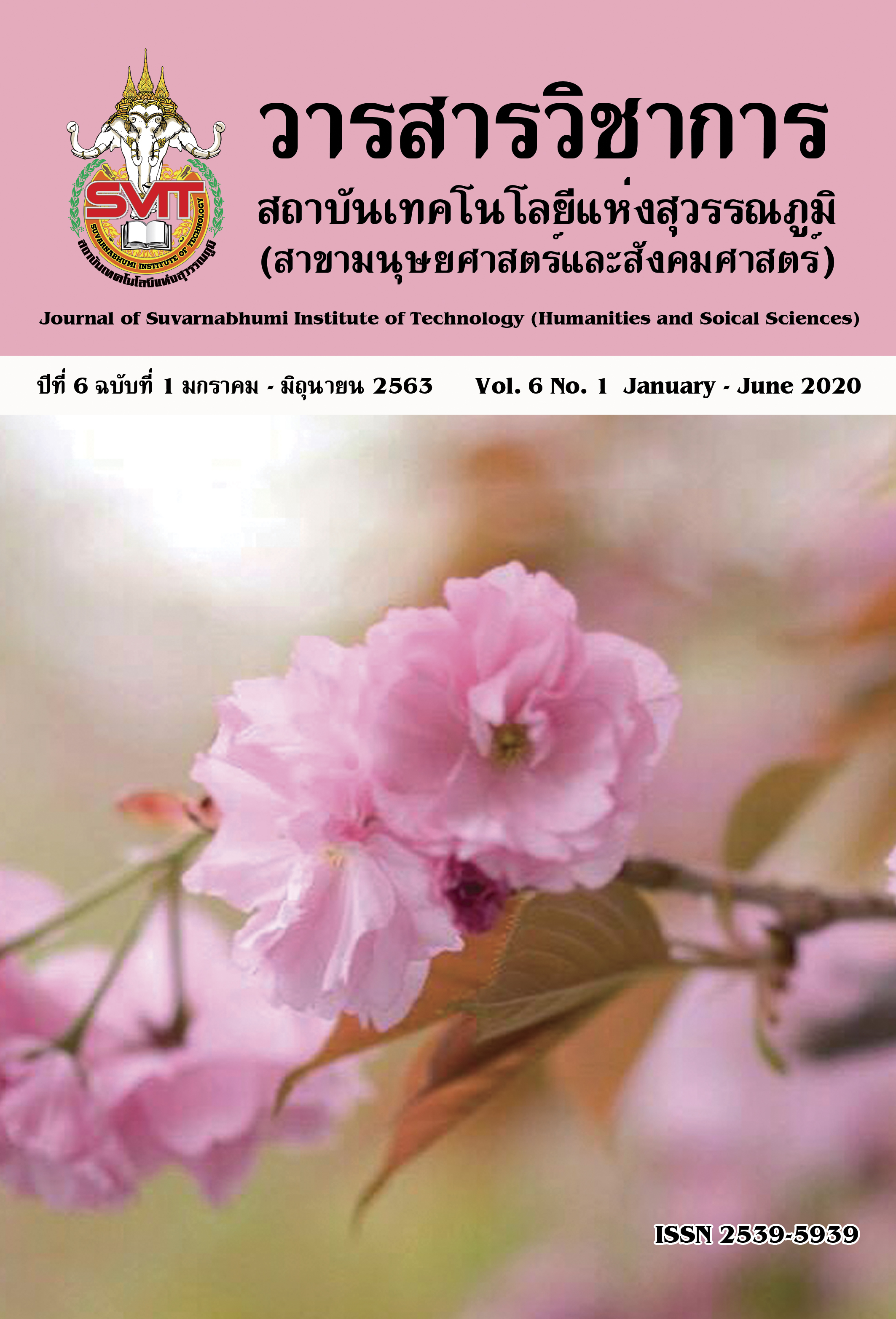INFORMATION TECHNOLOGY MANAGEMENT DEVELOPMENT APPROACH TO ENHANCE THE SUPPLY CHAIN MANAGEMENT OF STONE CRUSHING INDUSTRY
Keywords:
Information Technology Management, Supply Chain Management, Business Administrator Management, Stone crushing industryAbstract
The purposes of this research were (1) to study the pattern and model of business administration management of stone crushing Industry. (2) to study the pattern of Information technology and supply chain management of stone crushing industry, and (3) to find out the pattern and model of Information technology development approach to enhance the supply chain management of stone crushing industry. This research is a qualitative research by In-depth interview method using interview guideline with the purposive sampling key informants in 4 groups; 1) Entrepreneur of stone crushing industry 2) Employees of stone crushing industry 3) Specialist and expert in stone crushing industry and 4) Academic Officer of stone crushing industry. The sample size in this research is 44 people in stone crushing industry of Saraburi province.
The research results found that manufacturing processes of stone crushing industry are fairly uncomplicated. The production, till this day, still adopts the inaction strategy which mandates to employ limited number of low skilled labors. Since the production processes have relied heavily on the use of machines and equipment, as a result of this, the continuous development for upgrading machines and equipment are required high skilled labors that can possess ability to perform effective maintenance works especially excavator and heavy-duty crushing machine. The key successful factor in business is the quality of resources; however, most of the rock quarrying and crushing plants are situated in the aggregated concession zones which reflect the same quality of resources. Therefore, many businesses adopt competitive pricing strategies and try to differentiate the logistics strategies to cut transportation costs. Moreover, the study has shown that the industry needs major improvement on strategic planning in the areas of resource management and workforce since the job descriptions have not been prescribed clearly thus the manner of business is to follow the existing processes from generation to generation.
Supply chain management; the evidence has represented that the industry has not underpinned the direction of supply chain management. The traditional work is mainly focused on the productivity process to reach the order of demand. Only a few business sectors can synchronize to the responsive supply chain but still lack planning for feasible solutions. One worker is assigned to perform multiple job holdings.
Scarcity in knowledge of Information technology, Industry does not embrace the utilization of IT. The IT is applicable for specific activities such as sales report and accounting. Data gathering procedure are not acquired in systematic approach therefore; the sales forecast and resource management directly affect poor data network management.
According to the research, the model of Information technology development approach to enhance the supply chain management of stone crushing industry found that 3 stages of “BASCIT”: 1) Develop fundamental business administrator management (BAM) element, which focuses on strategic planning, resource management then virtually becomes monitor and evaluation processes. 2) Enhance the capacity of supply chain management (SCM); design effective manufacturing processes to deliver the standardized product. 3) Maximize the potential of information technology management (ITM), Optimize further technological advancement as a tool to implement effective supply chain management. That is necessary to complete BASCIT in each stage before going to the next step.
References
กรมอุตสาหกรรมพื้นฐานและการเหมืองแร่. (2559). ปริมาณผลผลิตหินปูนและอุตสาหกรรมปูนซีเมนต์ของจังหวัดสระบุรี และทั้งประเทศ. กรุงเทพฯ: โรงพิมพ์ กพร.
กระทรวงอุตสาหกรรม. (2559). แผนยุทธศาสตร์กระทรวงอุตสาหกรรม พ.ศ. 2559-2564. กรุงเทพฯ: กระทรวงอุตสาหกรรม.
กัญญามน อินหว่าง. (2558). การจัดการสมัยใหม่ (ฉบับปรับปรุง). มหาวิทยาลัยเวสเทิร์น.
กัญญามน อินหว่าง และคณะ. (2559). รูปแบบความต้องการแรงงานของผู้ประกอบการต่อวิชาชีพที่สามารถย้ายแรงงานฝีมืออย่างเสรีในประชาคมอาเซียน. ทุนสนับสนุนงานวิจัย. มหาวิทยาลัยเอเชียอาคเนย์.
คำนาย อภิปรัชญาสกุล. (2550). โลจีสติกส์และการจัดการซัพพลายเชน กลยุทธ์สำหรับลดต้นทุนและเพิ่มกำไร. กรุงเทพฯ: บริษัทโฟมีเดีย แอนด์ พับลิชชิ่ง จำกัด.
สำนักโลจิสติกส์. (2555). แนวการประยุกต์ใช้เทคโนโลยีสารสนเทศ ในการบริหารจัดการระบบโลจิสติกส์และโซ่อุปทานในภาคอุตสาหกรรม. กรุงเทพฯ: สำนักโลจิสติกส์ กรมอุตสาหกรรมพื้นฐานและการเหมืองแร่.
สำนักโลจิสติกส์. (2557). Green Supply Chain Logistics Management for Food Processing Industry การจัดการโลจิสติกส์และโซ่อุปทานสำหรับอุตสาหกรรมอาหารแปรรูป ปี 2557. กรุงเทพฯ: กรมอุตสาหกรรมพื้นฐานและการเหมืองแร่.
Cao, Ning., Zhang, Zhiming., To, Kin, Man., and Ng, Keng, Po. (2008). “How are Supply Chains Coordinated.” Journal of Fashion Marketing and Management.
Chong, Alain, Yee-Loong., and Zhou, Li. (2014). “Damand Chain Management: Relationships Between External Antecedents, Web-Based Integration and Service Innovation Performance.” Int. Production Economics.
Juste, Victoria, Bordonaba., and Fierro, Jesus J, Cambra. (2009). “Managing Supply Chain in the Context of SMEs: a Collaborative and Customized Partnership with the Suppliers as the Key for Success.” Supply Chain Management: An International Journal.
Supply Chain Council, (1996). Supply Chain Operations Reference Model: SCOR. United State of America.
Downloads
Published
Issue
Section
License
Copyright (c) 2020 Suvarnabhumi Institute of Technology

This work is licensed under a Creative Commons Attribution-NonCommercial-NoDerivatives 4.0 International License.
บทความที่ได้รับการตีพิมพ์เป็นลิขสิทธิ์ของวารสารวิชาการ สถาบันเทคโนโลยีแห่งสุวรรณภูมิ
ข้อความที่ปรากฏในบทความแต่ละเรื่องในวารสารวิชาการเล่มนี้เป็นความคิดเห็นส่วนตัวของผู้เขียนแต่ละท่านไม่เกี่ยวข้องกับสถาบันเทคโนโลยีแห่งสุวรรณภูมิ และคณาจารย์ท่านอื่นๆในสถาบันฯ แต่อย่างใด ความรับผิดชอบองค์ประกอบทั้งหมดของบทความแต่ละเรื่องเป็นของผู้เขียนแต่ละท่าน หากมีความผิดพลาดใดๆ ผู้เขียนแต่ละท่านจะรับผิดชอบบทความของตนเองแต่ผู้เดียว





